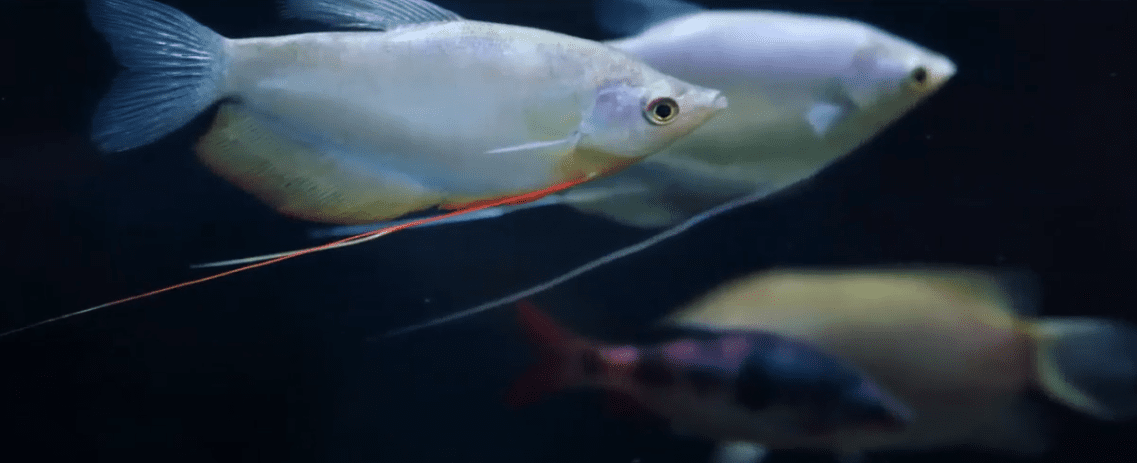Introduction
The Moonbeam Gourami, or Moonlight Gourami, is a captivating freshwater fish with a beautiful silver colour. Its shimmering appearance under aquarium lights adds tranquillity and beauty to any aquatic setting.
The Moonbeam Gourami is known for its slim body, long fins, and serene movement in water. Its body has a gentle shimmer and can display shades from pink to blue. This fish has a unique organ that lets it breathe air, making it adaptable to different water conditions.
The popularity of the Moonbeam Gourami among freshwater aquarium hobbyists can be attributed to its peaceful demeanour and striking appearance. It is a species that coexists harmoniously with a wide range of tank mates, making it a versatile choice for community aquariums.
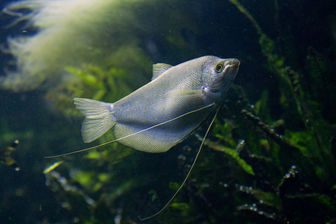
Additionally, its relatively straightforward care requirements appeal to novice and experienced aquarists alike. The Moonbeam Gourami’s ability to adapt to different environments and its captivating beauty have solidified its status as a cherished species in the aquascaping community.
Aquarists are drawn to the Moonbeam Gourami for its aesthetic appeal and the tranquillity it brings to the aquatic landscape. Its gentle nature and mesmerizing appearance make it a focal point in any tank, embodying the essence of aquatic elegance. As such, the Moonbeam Gourami continues to be a sought-after species, celebrated for its ability to transform an ordinary aquarium into a peaceful, underwater moonscape.
Key Take Aways
- Peaceful Nature: The Moonbeam Gourami is known for its calm and quiet demeanour, making it an excellent addition to community tanks. Its ability to coexist with other peaceful fish species allows for a harmonious aquatic environment, ideal for hobbyists looking to create a serene aquarium setting.
- Distinctive Appearance: The Moonbeam Gourami is a visually striking species with its shimmering silver body and long, flowing fins. Its ethereal beauty, highlighted by subtle iridescent colours, adds a unique aesthetic appeal to any aquarium, captivating the attention of aquarists and onlookers.
- Adaptability: This species is equipped with a labyrinth organ, enabling it to breathe atmospheric air and thrive in various water conditions. This adaptability makes the Moonbeam Gourami a resilient and versatile choice for aquariums, suitable for beginners and experienced hobbyists.
- Care Requirements: The Moonbeam Gourami has moderate care requirements, making it accessible to many aquarists. Its diet is omnivorous, accepting both live and prepared foods, and it prefers a well-planted aquarium with plenty of hiding spots. Understanding and maintaining the appropriate water parameters and tank conditions can ensure the health and longevity of these fish.
- Breeding and Compatibility: While the Moonbeam Gourami is relatively easy to breed in captivity, creating the right environment for bubble nest building is critical. Their compatibility with other peaceful fish makes them versatile for community tanks. However, care should be taken to avoid housing them with aggressive or fin-nipping species to prevent stress and injury.
Origin and Habitat
The Moonbeam Gourami, Trichopodus microlepis, originates from the tranquil waters of Southeast Asia, with a distribution that spans Thailand, Cambodia, and Laos. This species is typically found in slow-moving or stagnant waters, including ponds, swamps, and marshes, as well as in rice fields and floodplains.
These environments are characterized by dense vegetation above and below the water surface, providing the Moonbeam Gourami with ample hiding spots and a rich food source. The water in these habitats is often soft and acidic, with a thick layer of leaf litter on the bottom that contributes to the natural tannins and subdued lighting conditions under which this species thrives.
| Characteristic | Description |
|---|---|
| Scientific Name | Trichopodus microlepis |
| Common Names | Moonbeam Gourami, Moonlight Gourami |
| Origin | Southeast Asia |
| Family | Osphronemidae |
| Social | Peaceful |
| Domain in Tank | Top to middle layer |
| Minimum Tank Size | 30 gallons (113 liters) |
| Diet | Omnivorous (prefers live food but will accept flakes and pellets) |
| Breeding | Bubble nester: relatively easy under the right conditions |
| Care Level | Moderate |
| pH Range | 6.0 – 7.5 |
| Water Hardness | 5-18 dGH |
| Temperature | 75-82°F (24-28°C) |
| Common Diseases | Ich, fin rot (less common with proper care) |
| Life Span | 4-6 years |
| Size | Up to 5 inches (12.7 cm) |
| Best Tank Mates | Other peaceful fish of similar size; avoid fin nippers and very large fish |
The natural habitat of the Moonbeam Gourami plays a crucial role in its behaviour and physiology. The presence of the labyrinth organ allows it to survive in oxygen-poor waters by breathing atmospheric air, a trait particularly advantageous in the stagnant or slow-flowing waters of its native environment.
The lush, plant-dense habitats offer protection from predators and support a diverse diet, ranging from small invertebrates to plant matter.
This backdrop of serene waters and abundant vegetation is essential for understanding the care and environment needed to successfully keep Moonbeam Gouramis in home aquariums, mirroring their natural conditions as closely as possible.
Physical Description
With its slender and elongated body, the Moonbeam Gourami typically reaches up to 5 inches (12.7 cm), presenting a graceful and streamlined appearance. Its most captivating physical characteristic is its luminous, silvery body, which seems to glow under aquarium lighting, reminiscent of moonlight reflecting on water.
This glow is further enhanced by subtle hues of blue and pink that shimmer across its scales, creating a mesmerizing effect. The fish’s fins are another point of interest; the dorsal and anal fins are particularly long and delicate, extending towards the tail, and move with a gentle, wave-like motion that adds to the species’ ethereal beauty.
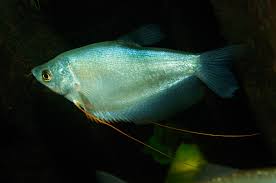
The ventral fins are thin and thread-like, for precise movement and water navigation.
The name “Moonbeam” or “Moonlight Gourami” is derived from this species’ remarkable ability to reflect light, mimicking the gentle luminescence of moonbeams.
This unique characteristic distinguishes it from other gourami species and embodies the tranquil ambience these fish bring to their aquatic environment.
Their glowing appearance and peaceful nature make the Moonbeam Gourami a living embodiment of a moonlit night, calm and full of quiet beauty, thus earning its celestial namesake.
Gender Differences
Gender differentiation in Moonbeam Gouramis can be subtle but becomes more discernible as they mature. Typically, males exhibit a slightly more vibrant colouration and have longer, more pointed dorsal and anal fins compared to their female counterparts.
Conversely, females tend to have a rounder, fuller body shape, especially when gravid or full of eggs. This distinction is a fascinating aspect of their biology and crucial for aquarists interested in breeding. The male’s enhanced colour and finnage become particularly pronounced during courtship displays, adding another layer of beauty to this captivating species.
Understanding these gender differences is essential for providing the right conditions for breeding and for the general well-being of the fish, ensuring a balanced and harmonious aquarium environment.
Behaviour and Temperament
Moonbeam Gouramis exhibit notably serene and gentle behaviour in their natural habitats and home aquariums, distinguishing them as one of the most peaceful species within the freshwater aquarium community.
In the wild, these fish navigate Southeast Asia’s calm, densely vegetated waters in a graceful, almost contemplative manner, often seeking refuge among plants and submerged structures. This preference for sheltered environments translates well to aquariums, where they prefer well-planted tanks with ample hiding spots.
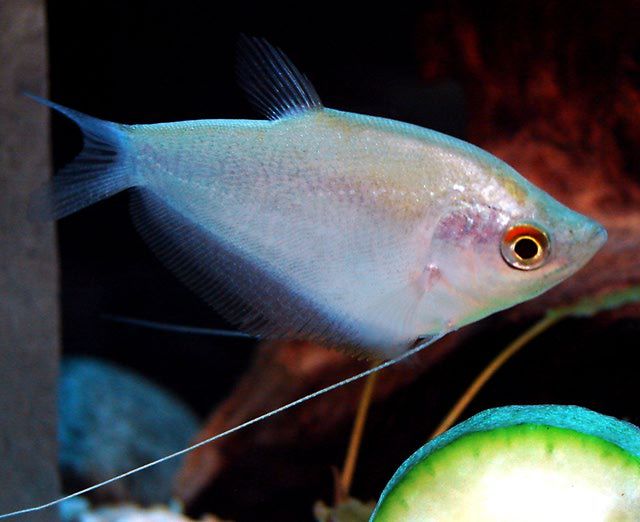
The Moonbeam Gourami’s temperament is characterized by its non-aggressive interactions with tank mates; they are known to coexist harmoniously with a wide array of other peaceful fish, making them an ideal candidate for community aquariums.
Their social behaviour is marked by a mild-mannered disposition, avoiding confrontation and rarely displaying territorial tendencies. This peaceful nature allows them to integrate seamlessly into the social structure of a mixed-species tank, contributing to the overall tranquillity and balance of the aquatic ecosystem.
Aquarium Requirements
For Moonbeam Gouramis, a minimum tank size of 30 gallons is recommended to provide ample swimming space and accommodate their preference for a well-structured environment.
This size allows for creating a naturalistic setting that closely mimics their native habitats in Southeast Asia, which are often calm, densely planted waters. To replicate these conditions, aquarists should consider a soft, dark substrate that enhances the natural colours of the Moonbeam Gourami and supports the growth of various aquatic plants.
Live plants such as Java Fern, Anubias, and Water Wisteria can provide shelter and hiding spots, which is crucial for the well-being of this somewhat shy species. Additionally, incorporating driftwood and smooth rocks can add to the aesthetic appeal of the tank while offering more hiding places and surfaces for algae and biofilm to grow, which these gouramis may graze on.
Floating plants are also a great addition, as they help to diffuse lighting and create dimmer areas in the tank, mimicking the shaded waters of their natural environment and encouraging natural behaviours. This setup caters to the physical needs of the Moonbeam Gourami and supports a healthy psychological state, promoting a more active and vibrant fish.
Water Conditions
- Ideal Water Parameters:
- Temperature: 75-82°F (24-28°C)
- pH Level: 6.0-7.5
- Water Hardness: 5-18 dGH
- Monitoring and Maintenance:
- Regularly monitor water temperature and quality using reliable aquarium thermometers and water testing kits.
- Perform weekly water changes of 10-25% to maintain water cleanliness and prevent the buildup of harmful substances.
- Filtration and Water Quality:
- Utilize a gentle filtration system to keep the water clear while avoiding strong currents that could stress the Moonbeam Gouramis.
- Consider peat filtration or adding driftwood to naturally soften the water and adjust pH levels.
- Creating a Suitable Environment:
- Mimic the natural habitat of Moonbeam Gouramis in the aquarium setup to promote their health and enhance their colouration.
- Closely monitor and adjust the aquarium’s water parameters to ensure a thriving environment for the Moonbeam Gourami.
Diet and Feeding
In the wild, the Moonbeam Gourami’s diet is diverse, consisting of small insects, larvae, plankton, and algae, reflecting their omnivorous nature. This varied diet contributes to their health and vibrant appearance. In captivity, it’s essential to mimic this natural diet to ensure the Moonbeam Gourami receives the necessary nutrients for optimal health and colouration.
A balanced diet for these gouramis should include high-quality flake food and frozen or live foods such as brine shrimp, bloodworms, daphnia, and vegetable matter. Incorporating algae wafers or blanched vegetables like zucchini and spinach can also provide the necessary fibre.
Feeding should occur 1-2 times daily, with the amount they can consume within a few minutes, to avoid overfeeding and maintain water quality.
Periodically varying their diet meets their nutritional needs and keeps them engaged and active, mirroring the foraging they would do in their natural habitat.
Health and Care
Like many aquarium fish, Moonbeam Gouramis are susceptible to common health issues such as ich (white spot disease), fin rot, and fungal infections, particularly when stressed by poor water conditions or overcrowding. Ich presents as small, white, grain-like spots on the fish’s body and fins, while fin rot causes the edges of the fins to appear frayed or discoloured.
Fungal infections are identified by white or cottony growths on the fish’s skin or fins. Preventative care is paramount for maintaining the health of Moonbeam Gouramis.
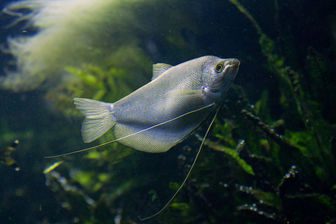
This includes regular monitoring of water parameters (temperature, pH, hardness) to ensure they remain within the ideal range, performing consistent water changes to keep the environment clean, and providing a balanced diet to support a robust immune system.
Quarantining new fish before introducing them to the main tank can also prevent the spread of diseases. Should any health issues arise, prompt treatment with the appropriate medications, following the manufacturer’s instructions, is crucial. For ich, treatments include raising the water temperature slightly to speed up the parasite’s lifecycle and using a commercial ich treatment.
Fin rot and fungal infections can be addressed with antibacterial and antifungal medications. Always ensure the treatment chosen is safe for all tank inhabitants, and consider moving affected fish to a quarantine tank during treatment to prevent the spread of disease and monitor their recovery closely.
Breeding
Breeding Moonbeam Gouramis in captivity is a fascinating process that requires careful preparation and attention to detail. These fish are bubble nest builders, with the male constructing a floating nest out of air bubbles and plant debris at the water’s surface to attract a female for spawning.
Once the female lays her eggs, the male fertilizes them and carefully gathers them into the bubble nest. Post-spawning, removing the female from the tank is crucial, as the male becomes highly protective of the nest and may exhibit aggression towards her.
The male guards and maintains the nest until the fry hatch, usually within 24-48 hours. After the fry becomes free-swimming, which takes about 2-3 days, removing the male is also advisable to prevent any potential harm to the offspring. Raising the fry requires providing infusoria or commercially prepared food until they are large enough to accept crushed flakes or baby brine shrimp.
Maintaining clean water and a stable temperature is critical to ensure the fry’s healthy development. Breeding Moonbeam Gouramis can be rewarding, offering aquarists a closer look at the fascinating reproductive behaviours of this species and the joy of nurturing the next generation.
Compatibility with Other Fish
When selecting tank mates for Moonbeam Gouramis, choosing species that share their peaceful nature is crucial to ensure a harmonious aquarium environment. Ideal companions include similarly sized, non-aggressive fish such as tetras, rasboras, and danios, which thrive in the same water conditions and do not compete aggressively for food.
Corydoras and other small, peaceful bottom-dwellers also make excellent tank mates, as they occupy different tank levels, reducing the potential for territorial disputes. It’s advisable to avoid housing Moonbeam Gouramis with known fin-nippers like some barbs and more prominent, more aggressive species such as cichlids, which can cause stress or harm to the gouramis.
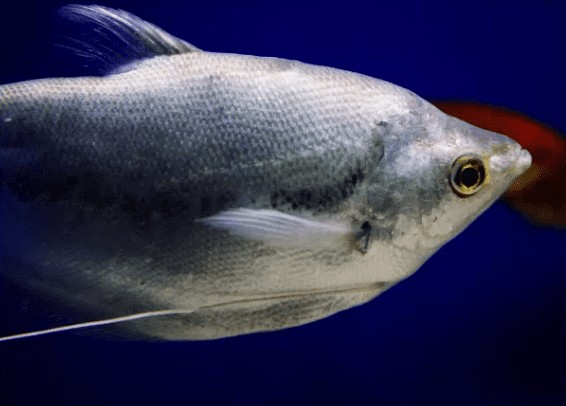
Additionally, very small, shy species may be outcompeted for food by more active fish. By carefully selecting tank mates that match the Moonbeam Gourami’s peaceful and easygoing temperament, aquarists can create a visually appealing and stress-free environment for all inhabitants.
Summary
With its serene demeanour and captivating appearance, the Moonbeam Gourami stands out as a jewel among freshwater aquarium species. Its peaceful nature ensures compatibility with various tank mates, fostering a harmonious aquatic community.
The distinctive shimmering silver hue and graceful fins of the Moonbeam Gourami add an unparalleled aesthetic value to any tank, creating a tranquil underwater landscape that mesmerizes onlookers. Adaptability is another hallmark of this species, with its labyrinth organ allowing it to thrive in various conditions, making it a resilient choice for novice and seasoned aquarists.
Furthermore, the moderate care requirements and the potential for breeding in home aquariums add to its appeal, offering enthusiasts a rewarding experience.
In summary, the Moonbeam Gourami’s blend of beauty, peacefulness, and adaptability makes it an exceptional choice for anyone looking to enrich their aquatic environment with a touch of elegance and tranquillity.

